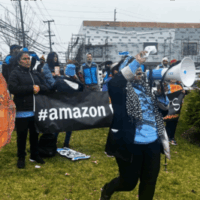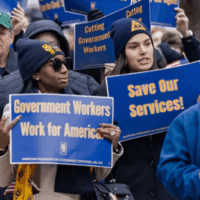Following is a statement from Laura Padin, senior staff attorney with the National Employment Law Project, on the NLRB Office of the General Counsel’s Advice Memorandum, issued today, finding that Uber drivers are independent contractors rather than employees:
“This NLRB advice memo ignores the reality of Uber’s relationship with its drivers and the myriad ways in which it controls the terms and conditions of their work. But it’s hardly a surprise coming from the Trump administration, which has shamefully sided with big-money corporate interests over working people at every turn.
“The advice memo concludes that Uber drivers are independent contractors, not employees, because they can decide where and when to driver for Uber—without acknowledging the ways Uber influences these choices, such as through surge pricing (setting higher prices—and higher driver pay—for certain times and places).
“Nor does the opinion give proper weight to the many terms and conditions of the drivers’ work over which Uber maintains unilateral control, such as the pay rate for drivers, which is often below the minimum wage, and the many requirements that drivers must adhere to—including a high ride-acceptance rate, a low pickup-cancellation rate,[1] and a very high average customer rating—or risk temporary or permanent ‘deactivation.’
“In fact, drivers have so little independence that they don’t know where they are taking a passenger or what they might expect to earn from a trip until that passenger steps in the car. Uber drivers are not running their own business, which is what it means to be an independent contractor. Uber drivers do not set their own rates; they do not choose their customers. They are not making investments in a business; they are performing the core work of Uber.
“Uber labels its workers as independent contractors in order to avoid the benefits and protections—including the right to bargain collectively—that are owed to employees, even though Uber drivers are not, by any stretch of the imagination, in business for themselves. This Board, in direct contrast to the Obama-era Board, continues to put its thumb on the scale to reward companies that shirk their obligations to their workforce. We need a Board that will stand up for workers, not the companies that engage in race-to-the-bottom workplace practices.”
The National Employment Law Project is a non-partisan, not-for-profit organization that conducts research and advocates on issues affecting low-wage and unemployed workers. For more about NELP, visit www.nelp.org. Follow NELP on Twitter at @NelpNews.
[1] “Generally, Uber requires drivers to maintain a high ride acceptance rate, such as 80% or 90%, and a low cancellation rate, such as 5% in San Francisco (as of July 2015), or they risk deactivation (temporary suspension or permanent firing) from the platform.” Alex Rosenblat, The Truth About How Uber’s App Manages Drivers, Harvard Bus.Rev., Apr. 26, 2016, https://hbr.org/2016/04/the-truth-about-how-ubers-app-manages-drivers.
Related to
The Latest News
All newsMayor Bowser & D.C. Council Must Respect the Will of D.C. Voters by Rejecting Repeal of Initiative 82

Blog
New Brief Sheds Light on the Amazon’s Dangerous ‘Flex’ Labor Model

News Release
NELP Denounces Supreme Court Ruling Permitting Immediate Layoffs of Hundreds of Thousands of Federal Workers

News Release
